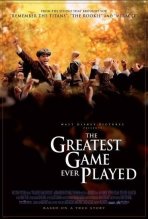Criteria of Greatness
/Thanks to reader John for the heads up on this piece by John Steinbreder. He writes about what he likes at the best clubs in golf.
When you come to think of it that is the secret of most of the great holes all over the world. They all have some kind of a twist. C.B. MACDONALD

Thanks to reader John for the heads up on this piece by John Steinbreder. He writes about what he likes at the best clubs in golf.
 There are 26 PGA Tour players topping the 300-yard average mark following the Texas Open, that's two more than last week.
There are 26 PGA Tour players topping the 300-yard average mark following the Texas Open, that's two more than last week.
On August 29, this site speculated that we might see 25 players finish the season averaging over 300 yards this year. Oops! Now 30 is well within reach! (And remember, the Tour average was down 7 yards through the Masters because of the weather...or guys working out less?).
So the number of players breaking the 300 barrier (that's on average!!) may double the 2004 total, when 14 players averaged over 300 yards. 9 players averaged over 300 yards in 2003.
Repeating the key stats here, John Daly was first and only player averaging over 300 yards for the 1997, 1999, 2000, 2001 and 2002 seasons.
And one more bit of perspective: Dan Pohl led the Tour in 1980 at 274.3 yards. In 1995, Pohl's total would have landed him 16th in overall distance average. In 2000 Pohl's 274.3 would have been 84th on the list. And his 274.3 would put him 195th on this year's list, ahead of only nine others.
Some fun stuff from Thomas Boswell's Presidents Cup column:
In a year or two, perhaps we'll know whether this week at RTJ, with the touch of Jack and Barbara Nicklaus setting the tone, will actually transform the Americans into a true team. One player brought a sports page to read to the final interviews because he doubted he'd be asked questions and did a squeaky imitation of Nicklaus's voice. These guys aren't out of "Hoosiers" yet.
But this event might be a turning point. This time, it was the U.S. team at a victory podium doing its impromptu teasing skits as Nicklaus played father-figure moderator.
If one central U.S. player has to be melded with the rest of the team by a strong, even sarcastic captain's hand, it's Mickelson. And maybe only Nicklaus has the stature to do it.
Mickelson was asked about the indelible moment when, after making a five-foot birdie putt on the 18th to square his match with Angel Cabrera, he celebrated as though he thought he'd just won the Presidents Cup -- because he thought he had.
"I thought that that was it. I thought that we had won because I am an idiot and didn't read the rules of the game," Mickelson said. At that, the whole team melted in laughter.
"Better yet," Mickelson said, fingering himself further, "Captain Nicklaus told me on the 15th hole that there were no ties. Didn't quite get it. Still didn't get it."
"I thought you understood," Nicklaus said.
"You would think I would," Mickelson said.
"I told you there were no ties and you had to play to a conclusion," Nicklaus said, mischievously.
"Yeah, I thought you meant, 'Don't go for the tie. Go for the win.' "
More gales of delighted team laughter.
"Okay," Mickelson said sheepishly, "I got it, I got it."
While doing research for a story, I stumbled across this article on Tiger from May, 2001. He was asked if course design was in his future.
Jack Nicklaus, Arnold Palmer and Gary Player began their design businesses in their 30s and 40s. The 25-year-old Woods said he has no clear timetable for beginning a design career. He also said that he wouldn't necessarily design long courses just because he is known for his length.
"You really don't have to have the hole 470 or 480 yards for it to be challenging," Woods said.
I point this out because 470-480 was sort of still a "long" hole four years ago for most players, except maybe Tiger.
Yet how many times during the Presidents Cup did you see players hitting wedges into 475 yard holes? And NBC's announcers making sure to point it out?
While watching I was thinking that you would need another 75-100 yards to create a "long par-4" in the modern professional game, assuming you would like to see a mid-to-long iron approach.
George Archer passed away Sunday. Mark Soltau has a nice tribute at GolfDigest.com.
PGATour.com made the unusual move of predicting the outcome of Sunday's singles matches. Compare it with the final results.
Here are the player quotes on the day, and more here, including Chris DiMarco who made that impressive winning putt.
Ron Kroichik has an update on Harding Park and the various setup particulars for the upcoming World Championship event.
Thanks to reader Brian for this review of Trump National Los Angeles, host of the LPGA Tour this week.
“We took an average, nice course on a spectacular location and created a truly special golf course on a spectacular site,” [Donald] Trump says.
Of course, the former could be debated — average yes, but far from nice. Fairways & Greens was never a fan of the original Dye design, with its tight, overly penal landing areas, poor sightlines and hidden hazards. That the Earth tried to swallow the 18th hole seemed only fitting. It was a good walk spoiled.
But the original investors’ nightmare has become an oceanfront dream come true for golfers willing to pony up a few presidents.
And it’s worth every penny, especially if you’re a player who pays similar prices for Las Vegas courses that have neither the sea nor the scenery that swirl around this National treasure.
John Huggan compares the various Cups and quotes Greg Turner.
James Corrigan in the Independent writes about Seve's comments Saturday. Here's the entire transcript. A few of the more interesting exchanges:
Q. Apart from Tiger Woods, any of the Americans that impress you?
SEVE BALLESTEROS: Not really, no. Good swings, good players, but I thinking in that really keeps myself watching TV for a long time. It's true. Good players, good players. It's not easy to impress me, something special.
Q. Can you break that down a little?
SEVE BALLESTEROS: It would take a little long to explain that, we don't have time. Haven't even had lunch yet.
Q. Do you think that part of the reason is the ball that they play with and the equipment
SEVE BALLESTEROS: Yeah, I think it's a good point. You know, it's very hard because the newer equipment, with the metal woods, it's very hard to shape the shots because there's no grooves and it's difficult. The ball has dimples, they are designed with a specific dimple and they have a kind of trajectory. When I play on the course, it seems like they are turning to the right and it looks like they have radar and they come back to the fairway. It's true, it's more difficult to shape the ball on the course and equalize everybody with all of these new clubs, the putter, the 65 degrees loft in the club for certain players; with the grooves, the ball spins as good as ever. I said that a long time ago, and I'm going to say that again, that something has to be done with the rules now, otherwise golf will become more power than anything else.
Q. Inaudible?
SEVE BALLESTEROS: That's one of the reasons, yes. They play shots around the greens that, because of the equipment. But I understand, if they have the equipment available, they use it.
Q. How does it affect your game, the new equipment?SEVE BALLESTEROS: I'm happy with the Callaway equipment. I think they will do very good. Good ball. I have a new set of irons and I'm happy with the driver. Again, with the driver, it's difficult to shape. It seems to me no matter how you hit it, you have to hit it hard, and it goes or less straight. If you have a good tempo on the swing, as before it was much easier.
Q. A number of Europeans have gone to play in America
SEVE BALLESTEROS: I don't know. I don't know how many there are playing in America.
Q. More are playing
SEVE BALLESTEROS: I really haven't been keeping an eye very much on The European Tour for the last year and a half or so. If they go to America, there must be a reason.
Golfweek's Rex Hoggard previews the Presidents Cup singles matches and picks winners.
The Presidents Cup has made clear yet again that the players are trying their best to make golf entertaining despite once again playing a course that does little to inspire. This has been the case all year on the PGA Tour, yet all too often the drama never quite crescendos.
Perhaps it's the television coverage? Or more likely, the pace of play?
Vijay Singh did not hesistate to comment when given an opening after Saturday's dramatic Presidents Cup play.
Q. Talk a little about playing against Tiger and Furyk today, they seemed to be a pretty good team.
VIJAY SINGH: Yeah, just damned slow, just too slow. It took me it took us 5 1/2 hours to play. Getting up in the morning and playing with them, you know, it's okay when they are hitting the ball, but around the greens it just took forever to play. Towards the end, it took its toll.
I had a partner [Stuart Appleby] that wasn't very fast, either, and there's three guys that are playing you know, Tiger is fine around the tee shots or, you know, the second shot, but when he gets to reading putts and all that, they just took forever. You start hitting a minute a hole for a player and there's three of them, that's three minutes a hole, it adds up toward the end of the day. It just took forever.
Thankfully, someone brought Vijay back to the pace of play issue.Q. I think just watching the games on TV and a little bit in person, you seem like you're having more fun than almost anybody here. Is it just a fun week for you overall?
VIJAY SINGH: I don't know if I'm having fun, I'm here to win my matches and if I'm having fun doing it, you know, it's good for me.
I enjoy my teammates. I gel with them better than probably anybody else. I don't care who I get, I'm comfortable with everybody. So I just go out there and play my game and enjoy my company.
Q. If you played John Daly in a match in the Presidents Cup, how long would it take?
VIJAY SINGH: It's tough, it's not the speed of play, it's just how slow they play. I play with a few other guys that are very fast. I have a pace and I play to my pace. When you have to wait every single hole, I don't know what the officials are doing, you know, and we had 20, 25 minutes behind time, they are just not stepping up and saying, "hey, you are slow, hurry up."
 Bill Huffman in the East Valley Tribune looks what makes a golf movie work and he reviews The Greatest Game Ever Played, with quotes from the film's participants that would make the marketing department proud:
Bill Huffman in the East Valley Tribune looks what makes a golf movie work and he reviews The Greatest Game Ever Played, with quotes from the film's participants that would make the marketing department proud:
We met — which is how you phonetically pronounce Ouimet — Paxton during a party prior to the screening. Paxton knew one member of our foursome of amateur critics from their past days at Whispering Palms Golf Club in Rancho Santa Fe, Calif.
"It’s a movie that (golfers) will appreciate, and women will love,’’ said Paxton, who is better known as an actor for his roles in such films as "Apollo 13,’’ "Tombstone,’’ and "Weird Science."
We also met Frost, whose previous claim to fame came as a writer for the hit TV series "Hill Street Blues.’’ Frost said the movie was a "time machine" dating back to when "the athlete was a role model, which is not always the case in America these days."
Both Paxton and Frost were center-cut with their explanations of what to expect. Now, the question became, did the chemistry of the actors and plot in "The Greatest" work in a way that left people as moved as they were after watching "The Rookie?"
Well, one of our foursome did cry — and clap! — at the conclusion. But the best comment came from the other female member of the foursome, who said of "The Greatest": "If it came down to buying a movie ticket or renting the DVD, I’d wait for the rental."
The misunderstanding in the Love-Cink v. Weir-Immelman morning foursome play provided an interesting dilemma. Love thought he heard Weir suggest that the 1-2 foot putt was good, but Weir merely said that Cink had hit a great shot. Love picked up the ball. Weir protested, Immelman suggested it mean loss of hole. Captains were called in. Gary Player looked like he just woke up from a nap.
The PGA Tour official seemed perplexed, so guess who came to the rescue? That's right, the USGA's Tom Meeks.
He correctly ruled that because it was clearly a misunderstanding, Love could replace the ball with no penalty. Meeks cited Rule 18. Reader Blue Blazer emailed to suggest the ruling was correct, the rule cited by Meeks may not have been the right one.
2-4/3 Player Lifts Ball in Mistaken Belief That Next Stroke Conceded
Q. In a match between A and B, B made a statement which A interpreted to mean that his (A’s) next stroke was conceded. Accordingly, A lifted his ball. B then said that he had not conceded A’s next stroke. What is the ruling?
A. If B’s statement could reasonably have led A to think his next stroke had been conceded, in equity (Rule 1-4) A should replace his ball as near as possible to where it lay, without penalty.
Otherwise, A would incur a penalty stroke for lifting his ball without marking its position — Rule 20-1 — and he must replace his ball as near as possible to where it lay.
 Since I can't watch the Presidents Cup without wondering if Tiger's goatee is a tribute to Waiting For Guffman's infamous Corky St. Clair, I thought I'd track an hour of TNT's coverage.
Since I can't watch the Presidents Cup without wondering if Tiger's goatee is a tribute to Waiting For Guffman's infamous Corky St. Clair, I thought I'd track an hour of TNT's coverage.
In between plenty of commericals, plugs for TNT drama/NASCAR, blimp shots (that's of the blimp), a Jim Huber pre-packaged tribute to Jack and Gary, and my favorite, a graphic on "Presidents Cup Lefthanders," TNT showed us the following from 1-2 eastern:
27 putts
3 drives
16 approach shots or par-3 tee shots
5 chips
52 total shots in one hour of coverage. Not sure how that stacks up with other networks.
Oh, and I loved it when we saw Jack Nicklaus looking at the grass (probably trying to ID the variety), whild Bob Murphy told us that Jack was "pondering his thoughts."
Oh, and the first foursome took 2:20 to finish the front nine. And that's the short nine at RTJ GC.
Geoff Shackelford is a Senior Writer for Golfweek magazine, a weekly contributor to Golf Channel's Morning


Copyright © 2022, Geoff Shackelford. All rights reserved.